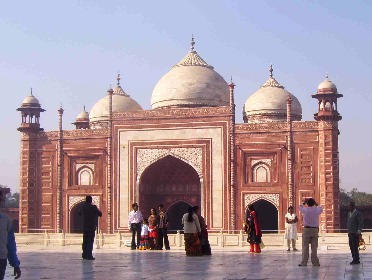
|
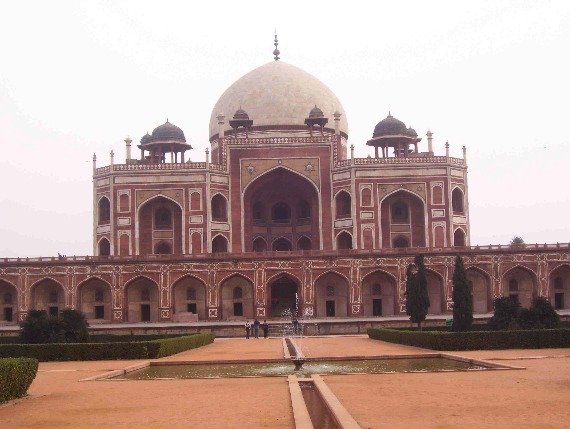
|
Mosque
at the Taj Mahal
|
Humayun's
Tomb
in Old Delhi
|
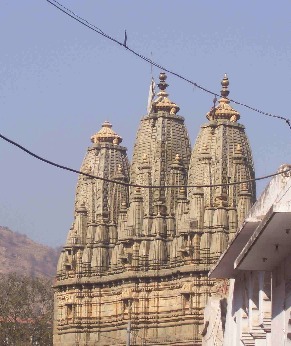
|
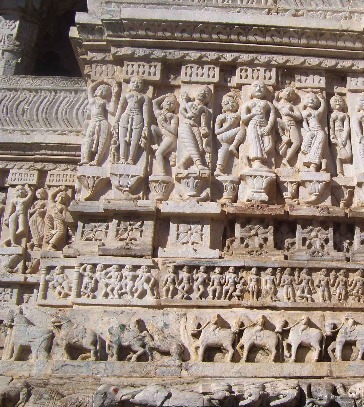
|
Hindu
Temple in Jaipur
|
Typical
Hindu Temple Carvings
|
Clothes were colorful and frequently gorgeous. Almost every woman
was wearing a saree, making the street scenes most colorful. Men’s
clothes varied from region to region, and depending upon their
religion. Male Sikhs wear a turban to cover their hair,
which they say is never cut during their lifetime. The
children fortunate enough to go to school wear uniforms, with
different colors and styles for different schools.
Security checks were everywhere with separate lines for men and
women. The picture above of the boys in brown uniforms and the
women in sarees was taken at the security check point for the Red
Fort in Delhi. Every hotel we stayed at was in a gated area
with security guards everywhere. And these precautions were
not just because of the November 2008 terrorist attacks, but
long-term arrangements to keep the local populations from the
hotel grounds.
Arranged marriages are still extremely popular (and great fun to
read the Sunday Paper Classified in which ads are placed by
parents seeking partners for their kids). Some of the more
highly educated young people are seeking their own partners, but
we were told that is still more the exception than the rule.
Bollywood (India’s Hollywood film industry located in Bombay)
makes over 1000 movies a year, with most having lots of songs and
dancing to support the plot of parents needing to marry off their
daughters. We were told that people go to see the same film over
and over again and then sing along. Kissing and sex scenes are not
allowed.
Poverty is rampant. It’s not just that there is poverty in
India, but the scale. T
he
Economist Magazine December 13, 2008, did an expose on
India. With over a billion people in India,
The Economist reported
that
42% live in poverty and that malnutrition is a serious
problem. It manifests itself when you see the housing,
the beggars and hawkers, and massive number of people just
“standing around.” We saw people sleeping on the street, in
make shift tents. We saw people and animals living
together. The sense is that half the people are street
people, and that's acceptable. We saw people burning
trash everywhere along the roads. These were small
fires, with one or two or three people (adults or children)
squatting next to them for warmth. The fuel was whatever
was at hand, mostly litter or trash, which was spewed
everywhere. The air was smoky/smoggy everywhere and almost all
the time.
School is not mandatory and the illiteracy rate is 60%. It
is so sad to see so many children just doing nothing, no
opportunity, no schooling, just marking time and begging. The
big money making engine in India is information and computer
technology, most particularly all the outsourcing from the US to
India for support services, but it is touching such a small
portion of the society. On the street the beggars and
hawkers are everywhere and in your face in the most upsetting
and obnoxious ways. We were advised to just ignore them
when walking down the street and being hassled, but that was so
hard to do. Seeing the poverty and human suffering was
just awful. We had one exceptional experience in
Mumbai. On our way to the airport our last day, we had a
driver and guide. Our guide told us that he lived in the
slums in a 186 square foot room with his parents, wife, and two
children. He said he and his wife had a loft for
privacy. He was extremely proud of the fact that he was
sending his two children to private school and paid $45 US a
month.
The caste system exists in India, among all religions, although
it is unconstitutional to discriminate against an individual
because of his or her caste. Individuals from the lowest
castes hold high office in the government and can be successful
in bettering their social/economic situation. Our first day in
India we spent the afternoon with a local lady who works in
guest relations at our hotel. Tthe hotel had so many
cancellations that she had plenty of time to talk to us.
She told us that she had married outside her caste and that was
a real problem for her parents and friends.
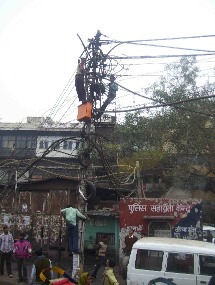
Electrical wiring
was fascinating, more because it apparently works. It
appears that when someone needed electricity, they climbed a
pole and installed a set of wires for themselves.
Corrupt government and patronage are the norm.
The Economist reported, “Of
the 522 members of India’s current parliament, 120 are facing
criminal charges” (page 5). We had a personal experience
with the system. When our trip ended, our 6:00 AM flight
from Mumbai to Bangalore was canceled by the airline, so we
wanted to change to the 9:00 PM flight the night before (so we
could make our connecting flight the next day). However,
“they” would not let us change the tickets. We ended up
having to pay a bribe ($70 US) to have the tickets
changed. The money went to a person, not the airline.
Indian perspective on history and the world was eastern centric
rather than western. We found after talking with many of
our local guides that in high school and college they studied
the history of Russia, Asia and the east rather than the western
cultural orientation, which dominates our schools. We need
to remember that throughout the Cold War, India and Russia were
allies, and relations with the West only grew after the fall of
the Berlin Wall in 1989 and changing the role of Russia.
The food was wonderful -- lots of great spices and
flavors. We had some really good Indian food. Meals
were spicy, even when we requested and they agreed to serve
“mild.” Their mild and our mild were worlds apart.
But we do now understand why 500 years ago Europeans were so
anxious to find a way to India and the spice islands: the
aromas, smells and tastes were wonderful (when they served the
food mild). We ordered cucumber raita (yogurt with
cucumber and flavored with salt and cumin seed) at almost every
meal. The yogurt counteracts the spice making the food
eatable.
While these themes re-appeared throughout our travels in the
north, west and south of India, each city we visited had
something unique to offer, and our hotels were an experience
unto themselves. Click the "City highlights" link for that
part of our adventure, and the "Hotel" link for description of
the palaces in which we stayed and the special cultural events
we attended (and our last week in the island paradise of the
Maldives).
Lois and Jason Travel Logs
Frand Family
Homepage
Photo
journalist: Lois Frand
February
5, 2009
Writer: Jason Frand
Editor:
Lois Frand
You can reach us via email at Jason
or Lois
February
5, 2009
 How can we ever
convey in words what we saw, smelled, felt, heard, and
touched? India was an immersion experience, with an intensity
that permeated our very being. Our western values, beliefs,
and culture were challenged on every front. To be in India was
to be worlds away from everything we take for granted. We chose
India because it was a part of the world we had never visited and
knew so little about, and this trip was just outstanding, one of the
most educational we've ever been on. The culture shock was
more drastic than we've previously experienced. To see so much
poverty and desperation was very upsetting. And, the cows,
dogs and monkeys everywhere, integrated into where people live,
work, drive, beg, and pray. On the other hand, our hotel
accommodations were incredibly spectacular, many built in the style
of the Taj Mahal. The contrast between what we saw and where
dune stayed was just another aspect of how life is lived in India --
in the extremes.
How can we ever
convey in words what we saw, smelled, felt, heard, and
touched? India was an immersion experience, with an intensity
that permeated our very being. Our western values, beliefs,
and culture were challenged on every front. To be in India was
to be worlds away from everything we take for granted. We chose
India because it was a part of the world we had never visited and
knew so little about, and this trip was just outstanding, one of the
most educational we've ever been on. The culture shock was
more drastic than we've previously experienced. To see so much
poverty and desperation was very upsetting. And, the cows,
dogs and monkeys everywhere, integrated into where people live,
work, drive, beg, and pray. On the other hand, our hotel
accommodations were incredibly spectacular, many built in the style
of the Taj Mahal. The contrast between what we saw and where
dune stayed was just another aspect of how life is lived in India --
in the extremes.